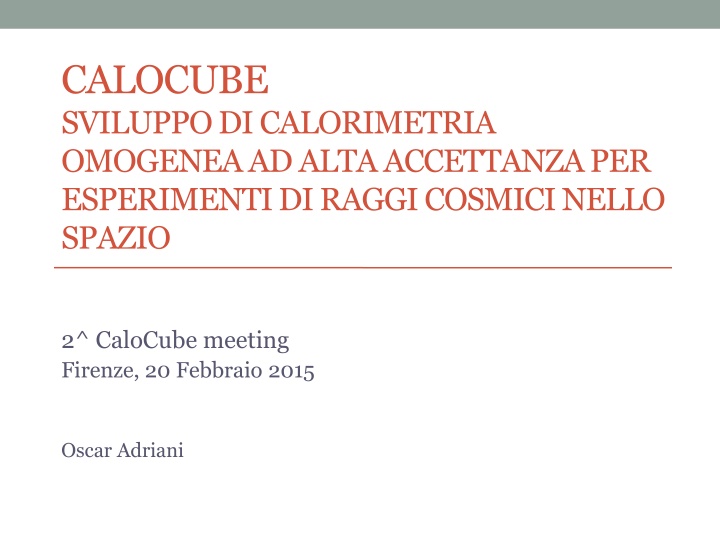
Advanced Development in Calorimetry for Cosmic Ray Experiments
Explore the innovative developments in calorimetry for cosmic ray experiments, including theoretical studies, simulation work, and testing of alternative geometries with optimized light collections. Discover the progress made since June 2014 and ongoing laboratory activities to enhance energy resolution and efficiency in space experiments.
Download Presentation

Please find below an Image/Link to download the presentation.
The content on the website is provided AS IS for your information and personal use only. It may not be sold, licensed, or shared on other websites without obtaining consent from the author. If you encounter any issues during the download, it is possible that the publisher has removed the file from their server.
You are allowed to download the files provided on this website for personal or commercial use, subject to the condition that they are used lawfully. All files are the property of their respective owners.
The content on the website is provided AS IS for your information and personal use only. It may not be sold, licensed, or shared on other websites without obtaining consent from the author.
E N D
Presentation Transcript
CALOCUBE SVILUPPODI CALORIMETRIA OMOGENEAAD ALTAACCETTANZAPER ESPERIMENTIDI RAGGICOSMICINELLO SPAZIO 2^ CaloCube meeting Firenze, 20 Febbraio 2015 Oscar Adriani
WHAT HAS BEEN DONE SINCE JUNE 2014
Theoretical studies and simulation Intense study of optical materials to optimize the Cherenkov light collections by Florence and Milan We bought many different crystals, that need to be tested Big simulation work: Energy resolution for many different materials See Talks by N. Daddi Studies on alternative geometries by P. Papini I will present now few slides
A more exotic solution Spherical configuration with small crystals with truncated octahedron shape More complex from the mechanical point of view Cubic configuration with small size cubic crystal Simpler from the mechanical point of view Basic ideas: Reduce as much as possible the leakages by avoiding possible escape planes Spherical geometry to increase the acceptance (maximize the surface, and hence the GF, once the weight is fixed) Optimization criteria: Crystals dimensions Gap btw crystals to increase the acceptance
gap l Size of the red square Size of the yellow cubic envelope Gap Volume Weight a = 1.2 cm l = 2 2 a = 3.4 cm gap = 0.8 cm V = 8 2 a3= 19.55 cm3 W = 139.4 g Single crystal Number of crystals along the diameter Total number of crystals External Diameter Total weight Depth on the diameter Geometrical factor 25 14361 103.6 cm 2002 kg 3.75 I 10.6 m2 sr Spherical calorimetric
The Spherical Calorimeter Energy resolution (%) 15 25 35 45 55 20 30 40 50 1 2 Proton 1 TeV BGO (27x27x27) 3 4 Effective geometric factor (m 5 Cubes Gap 6 (11.5 mm) Gap 4 (7.7 mm) Gap 2 (3.8 mm) Gap 1 (1.9 mm) Sphere 6 sr) 2 7
Very intense laboratory activities Test in Naples on the CsI(Tl)surface treatments See talk by G. Carotenuto/R. D Alessandro Production and tests of dichroic filters in Catania See talk by S. Albergo Measurements in Florence for: Detailed Characterization of the Casis chip See talk by L. Pacini Light collection efficiency (Vikuiti OK, Labsphere 6080 Not ok!!!!) Optical cross talk (killed by Tevlar ;) Activity in Trieste on the new CASIS chip See talk by V. Bonvicini
Mechanical studies Pisa/Siena group has studied the mechanics and we placed a big order for: FEM model and simulation 2 small (6x6) carbon fiber prototype planes 1 large (28x28) carbon fiber plane See talk by A. Basti
Calibration system Pulsed light calibration system is under study by the PV group See talk by P. Cattaneo
Test beams Intense analysis work on the past test beams analysis See talk by E. Vannuccini for SPS See talk by S. Albergo for BTF Organization of future test beams Setup of the Messina Linac line See talk by A. Trifiro Parasitic Test beam in H8 Ion Beam next week Official SPS test beam on H2 line (electrons and protons) from 15 up to 22 July See Talk by S. Albergo
Still to do Continue the work already described Increase the size of the prototype We bought xxx crystals at the end of 2014 Optical studies of the new type crystals Milan/Naples SiC tests and prototyping P. Lenzi got the CSN5 INFN grant for this! He will work on SiC in strict collaboration with CT Studies and prototype of Charge Identifier System Aerogel blocks look promising .
